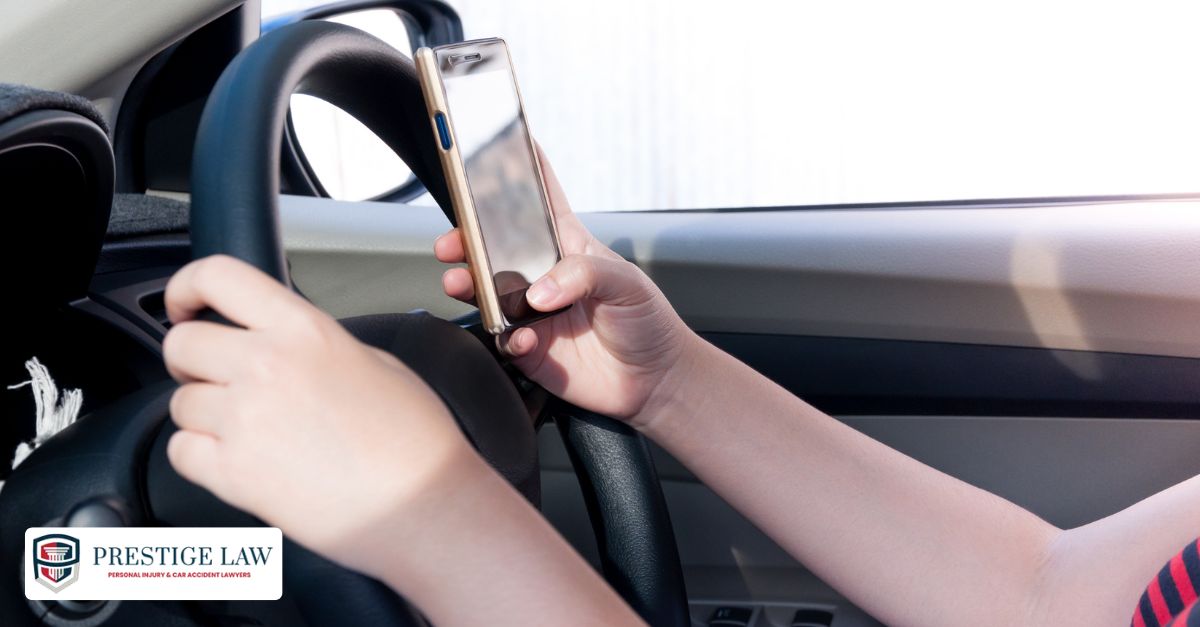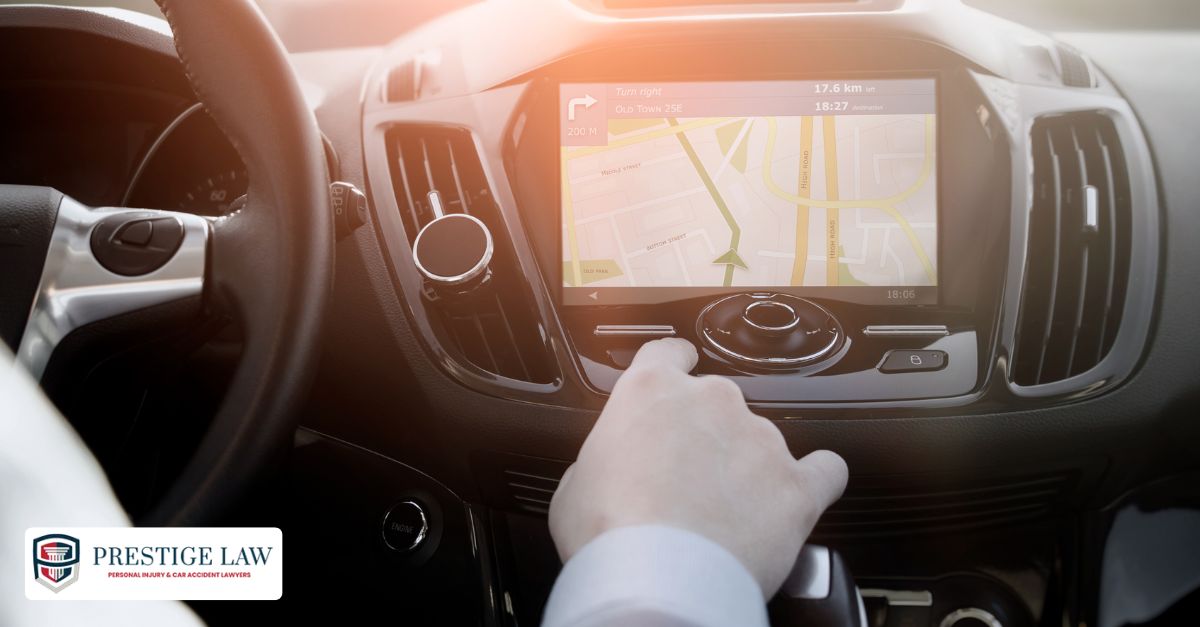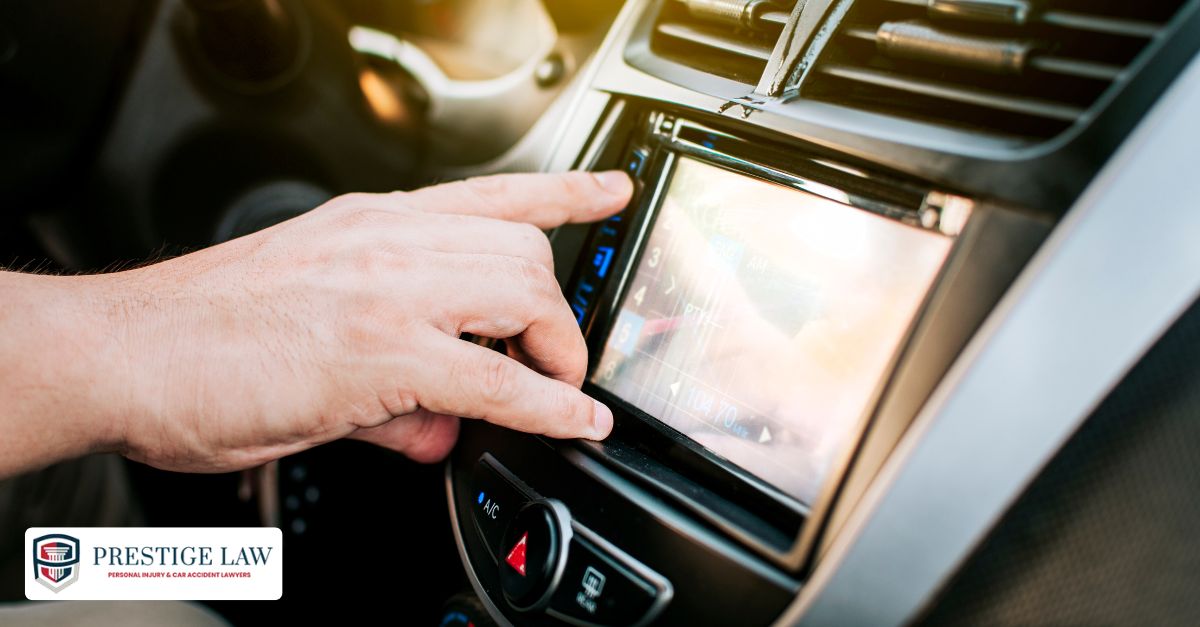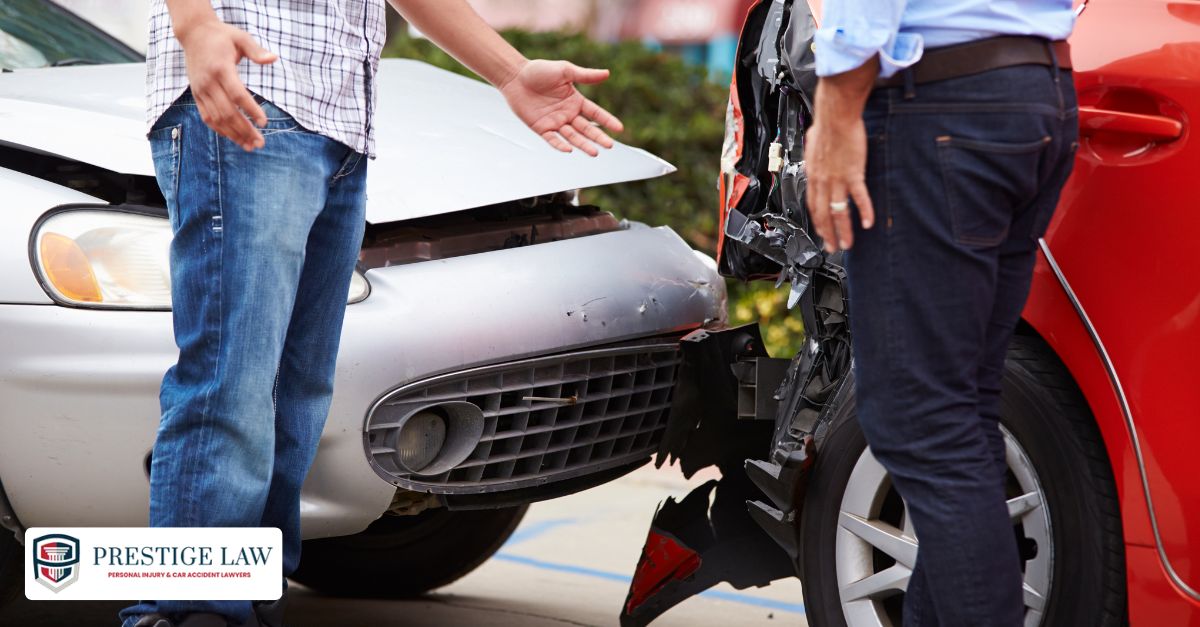
Distracted Driving: 3 Types That Lead to Accidents
Published on / Category: Car Accidents
Distracted driving causes thousands of preventable accidents each year in California. A single glance at a phone, a quick bite of food, or even a drifting mind can lead to devastating consequences in seconds.
These aren’t minor mistakes—they’re serious safety risks that affect everyone on the road.
There are three core types of distraction: visual, manual, and cognitive. Each one impacts drivers differently, but all reduce reaction time, limit awareness, and increase the chance of a crash.
Understanding how these distractions work—and how they affect liability—can help protect your safety and strengthen your case if you’ve been hit by a distracted driver.
Here is the Quick Answer:
Distracted driving falls into three categories: visual, manual, and cognitive. Texting while driving is the most dangerous because it involves all three. If you're injured by a distracted driver, collect evidence, avoid making statements at the scene, and contact a personal injury lawyer. Prestige Law Firm offers free consultations to help you recover compensation.
What is distracted driving?
According to the Centers for Disease Control and Prevention (CDC), distracted driving means operating a vehicle while doing anything that takes your attention off the road.
The National Highway Traffic Safety Administration (NHTSA) defines distracted driving as “any activity that diverts attention from driving.” This includes texting, eating, adjusting the radio, or talking to passengers.
These distractions can affect your:
- Eyes – looking away from the road
- Hands – taking one or both off the wheel
- Mind – thinking about something other than driving
Even simple actions like adjusting the radio or reading a message reduce your ability to react quickly. The more distracted you are, the greater your risk of causing or being involved in a crash.
Staying fully focused behind the wheel is not optional—it’s essential for your safety and the safety of others.
What are the three main categories of distracted driving?
Distractions behind the wheel fall into three major categories:
- Visual – taking your eyes off the road
- Manual – taking your hands off the wheel
- Cognitive – taking your mind off the task of driving
Each one reduces your ability to drive safely. Activities like texting while driving are especially dangerous because they involve all three types at once.
Understanding these categories not only improves safety but also plays a key role in determining liability after a crash.
Let’s break down what each type involves—and how it contributes to accidents.
1. Visual Distractions
Visual distractions happen when a driver takes their eyes off the road—even for a second. That quick glance can cause them to miss:
- A red light
- A stopped vehicle
- A pedestrian crossing
- A sharp turn or lane change ahead
Common visual distractions include:
- Looking at a GPS or navigation screen
- Reading a text or app notification
- Turning to talk to a passenger or look at something outside (like an accident or billboard)
- Adjusting dashboard settings like temperature or radio
Even looking away for just two seconds can double your risk of crashing, according to traffic safety researchers. These distractions are dangerous because they prevent you from seeing—and reacting to—sudden changes on the road.
2. Manual Distractions
Manual distractions involve taking one or both hands off the wheel while driving. This reduces your control over the vehicle and slows your ability to react in an emergency.
Examples of manual distractions include:
- Eating or drinking while driving
- Adjusting the radio, temperature, or seat position
- Reaching for items in the backseat or glove compartment
- Applying makeup or grooming
- Holding a phone to text, scroll, or make a call
Even small actions—like grabbing a coffee—can delay your response during sudden traffic changes. The more complex or prolonged the action, the higher the risk.
Manual distractions also often overlap with visual and cognitive distractions, making them especially dangerous.
3. Cognitive Distractions
Cognitive distractions happen when your mind drifts away from driving—even if your eyes are on the road and your hands are on the wheel. These are often the hardest to detect because they occur internally.
- Common cognitive distractions include:
- Daydreaming or mentally “zoning out”
- Thinking about work, errands, or personal issues
- Driving while upset, stressed, or fatigued
- Having deep conversations (even on hands-free devices)
- Getting absorbed in music, podcasts, or audiobooks
These distractions slow your decision-making and reduce your ability to react. A cognitively distracted driver might not even realize they missed a turn signal, ran a stop sign, or failed to yield.
What makes cognitive distractions especially risky is that they feel harmless—until they cause a serious crash.
Why Texting While Driving Is Especially Dangerous
Some activities involve more than one type of distraction—and texting while driving is the most dangerous of all.
When a driver texts, they are:
- Visually distracted – looking at the screen
- Manually distracted – using their hands to type
- Cognitively distracted – thinking about the message, not the road
This combination pulls focus from every part of safe driving. It only takes a few seconds of multitasking to miss a stoplight, swerve into another lane, or cause a rear-end collision.
That’s why texting while driving is one of the leading causes of car accidents in California and across the U.S.
Who is liable in a distracted driving accident?
If a driver causes a crash because they weren’t paying attention, they can be held legally responsible under California negligence law.
Negligence and Distracted Driving
Every driver has a duty of care to operate their vehicle safely. When they break that duty—by texting, eating, or zoning out behind the wheel—they may be found negligent if their distraction causes an accident.
Under California Civil Code §1714, a person is liable for injuries caused by their failure to use ordinary care. In distracted driving cases, that often means the at-fault driver may owe compensation for:
- Medical bills
- Property damage
- Lost wages
- Pain and suffering
Distracted Driving and California Law
In addition to civil liability, California has laws that prohibit certain distracting behaviors outright:
- Vehicle Code §23123.5 makes it illegal to use a handheld phone or text while driving
- Vehicle Code §23124 bans all cell phone use for drivers under 18—even hands-free
Breaking these laws can lead to citations and fines—but also strengthens the case against the driver in a personal injury claim.
How Distracted Driving Is Proven in Court
Unlike drunk driving, distraction isn’t always obvious at the scene. That’s why proving a distracted driving claim often depends on collecting the right evidence—and doing it quickly.
Here are the most common ways to show that a driver was distracted:
- Phone Records – Texts, calls, or app usage can be subpoenaed to reveal activity at the time of the crash.
- Dashcam or Surveillance Footage – Video can show the driver looking down, using their phone, or reacting too late.
- Eyewitness Statements – Passengers, pedestrians, or other drivers may have seen the at-fault driver eating, texting, or not paying attention.
- Accident Reconstruction – Experts can analyze speed, braking, and timing to show delays consistent with distraction.
- Police Reports – Officers may note if the driver appeared inattentive or admitted to being distracted.
These sources, especially when used together, create a compelling picture of what really happened. A skilled attorney can help gather this evidence and build a strong claim on your behalf.
What to Do After a Distracted Driving Crash
If you suspect the other driver was distracted, taking the right steps immediately after the crash can protect your health, your legal rights, and your chance to recover compensation.
Here’s what to do:
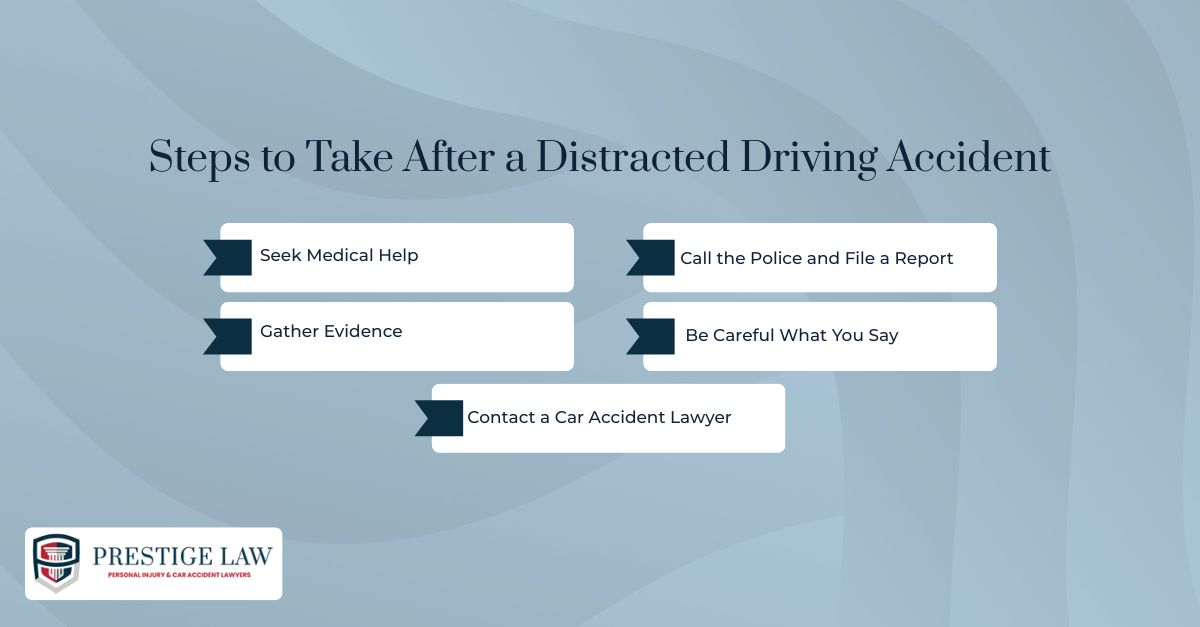
1. Seek Medical Help
Even if you feel okay, get checked by a medical professional right away. Some injuries—like whiplash, concussions, or internal trauma—may not show symptoms right away.
Your medical records will also serve as key evidence linking the accident to your injuries.
2. Call the Police and File a Report
A police report creates an official record of the incident. Tell the responding officer if you believe the other driver was distracted. If they were texting, eating, or looking away, this detail may be included in the report—strengthening your future claim.
In California, if a crash results in injury or death, the driver must submit a written accident report to local police or the California Highway Patrol within 24 hours, as required by Vehicle Code §20008.
3. Gather Evidence
If it’s safe and you’re able:
- Take photos of vehicle damage, road conditions, traffic signs, and injuries
- Get names and contact info from any eyewitnesses
- Write down anything the other driver said—especially if they admitted to being distracted
Early evidence often makes the difference when proving fault later.
4. Be Careful What You Say
Even if you believe the other driver caused the crash, avoid saying things that could be misinterpreted—like “I didn’t see you” or “I’m sorry.” Statements like these can be twisted into partial blame, even if you’re the one who was injured.
Let the evidence and witness accounts tell the story. Avoid guessing or speculating about what happened, and focus on making sure you’re safe.
5. Contact a Car Accident Lawyer
Before dealing with insurance adjusters, consult a personal injury lawyer. A skilled car accident lawyer can:
- Launch an investigation into the other driver’s distraction
- Request phone records or surveillance footage
- Deal with the insurance companies so you don’t have to
- Help calculate damages like medical costs, lost income, and pain and suffering
If you’re not sure where to start, Prestige Law Firm offers free consultations to help you understand your rights.
Conclusion
Distracted driving isn’t just careless—it’s dangerous. Every year, preventable crashes caused by momentary distractions lead to serious injuries, medical bills, and emotional stress for victims and their families.
Whether a driver glanced at a phone, ate behind the wheel, or simply lost focus, the outcome can change your life in seconds.
If you’ve been injured by a distracted driver in California, you don’t have to face the aftermath alone. Prestige Law Firm is here to help.
We provide experienced, personalized legal representation for injured clients across Van Nuys, Palmdale, and Los Angeles County. Founding attorney Paul Aghabala brings over two decades of experience in personal injury law, including distracted driving, catastrophic injuries, and wage loss claims.
We fight to secure the maximum compensation you deserve—and with our no recovery, no fee policy, you never pay unless we win.
📞 Call today for a free consultation: (818) 788-0808 or (661) 341-3939
📧 Email: paul@prestigelaw.com
Is texting while driving all three types of distraction?
Yes. Texting while driving involves visual, manual, and cognitive distractions, which makes it especially dangerous and more likely to cause a crash.
What happens if a distracted driver hits you?
If a distracted driver causes an accident, they can be held legally responsible. You may be entitled to compensation through a personal injury claim for medical bills, lost wages, and other damages.
How can you prove someone was distracted while driving?
Distracted driving is often proven using phone records, video footage, witness testimony, police reports, and expert analysis. A lawyer can help gather and present this evidence.
Get Started Today!
24 hours a day / 7 days a week / 365 days a year
Contact our Los Angles and Antelope team of attorneys for a free consultation.

